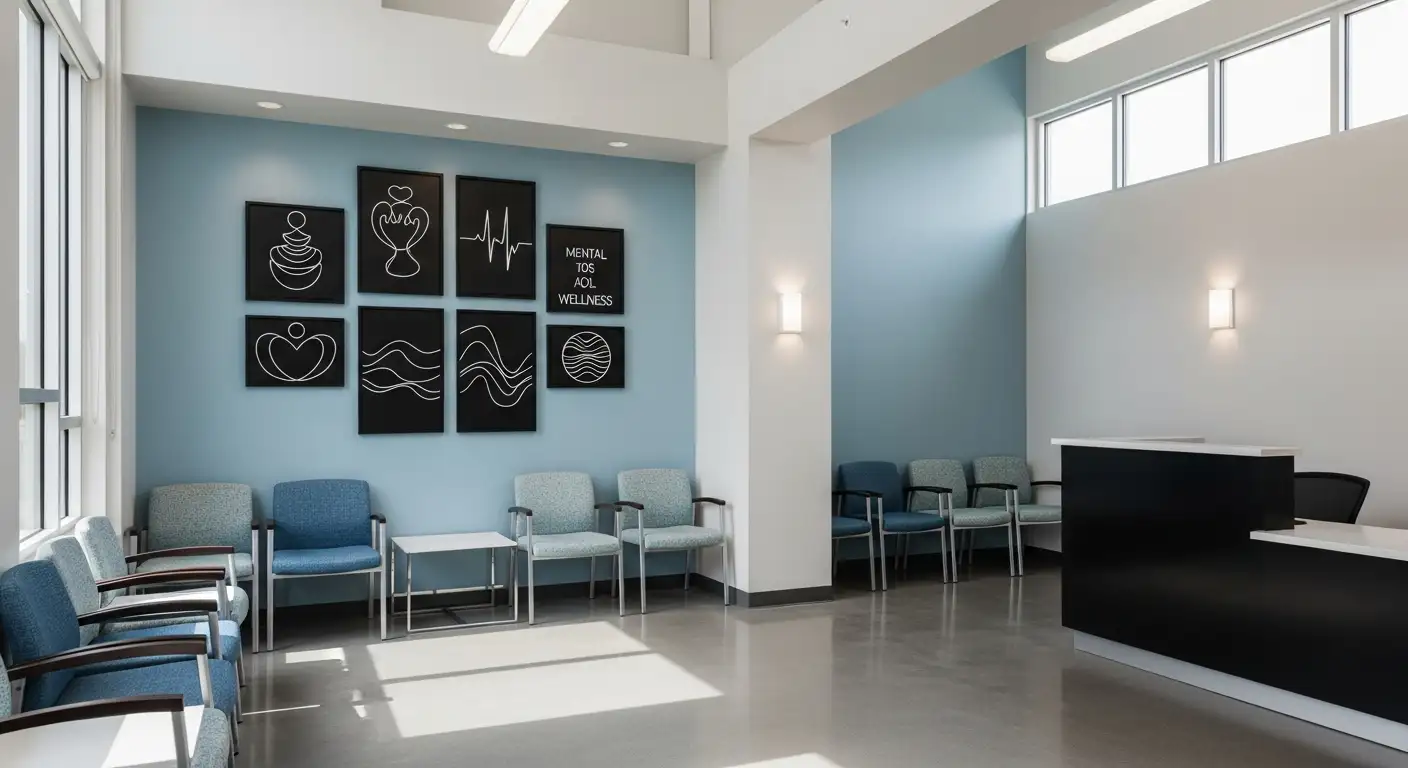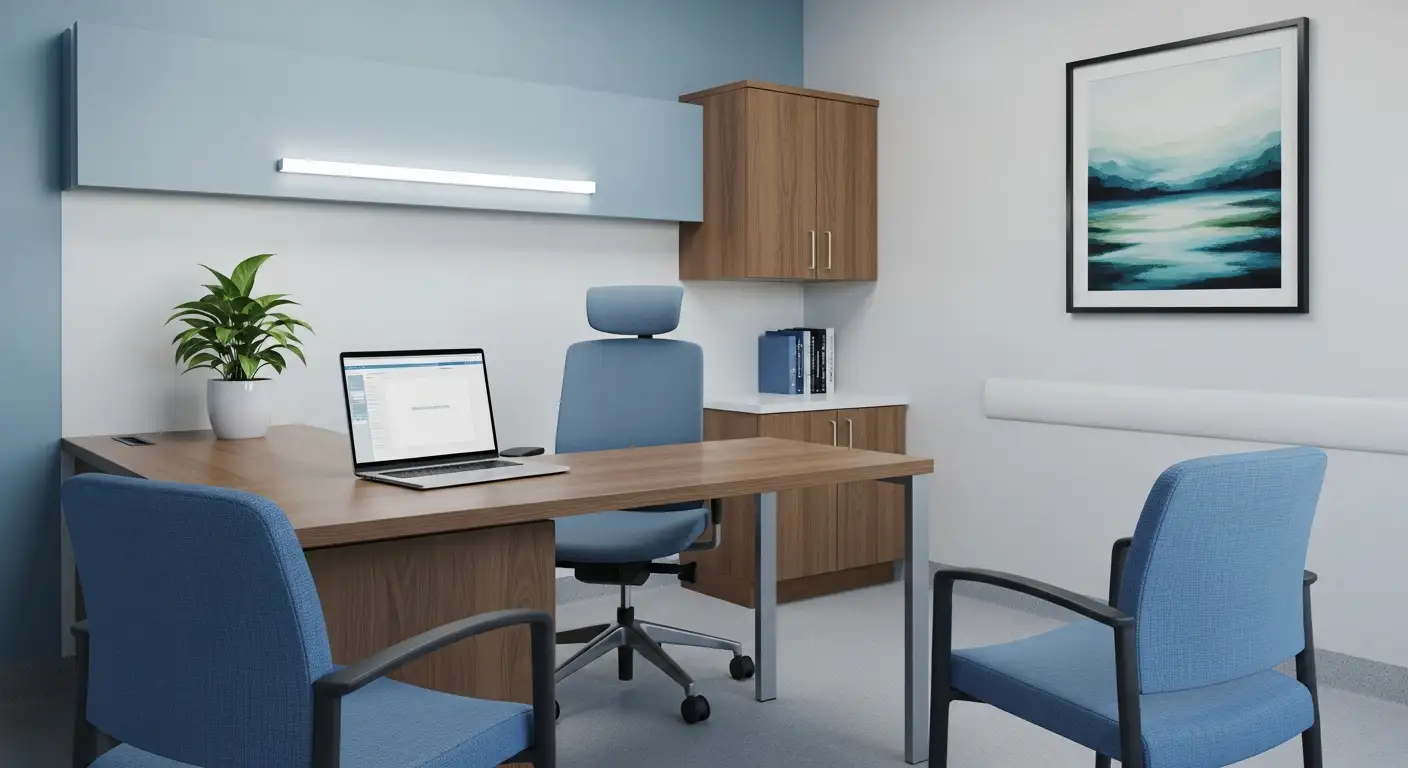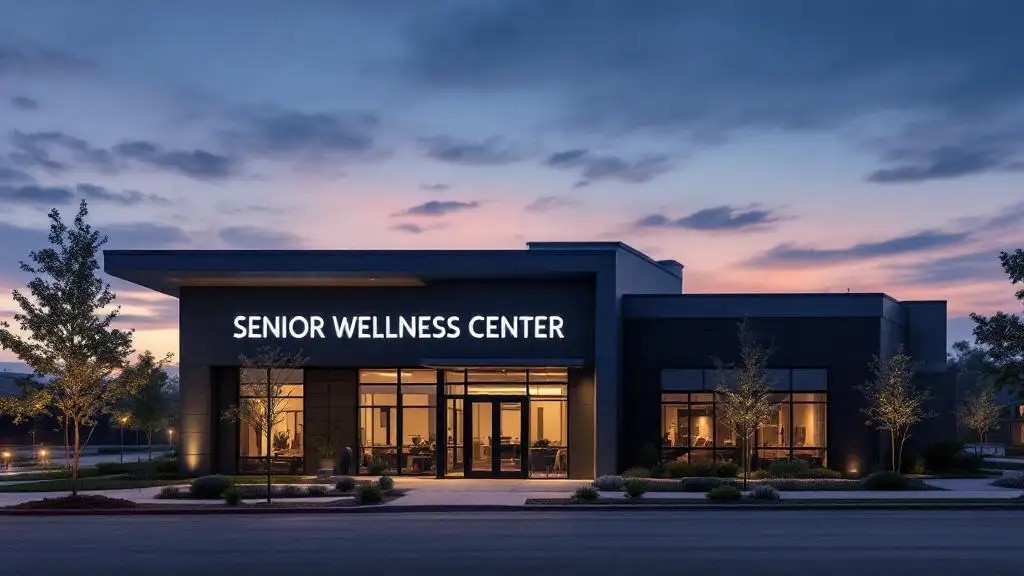Understanding the Stakes: Why Staffing Consistency Matters in Behavioral Health
In the complex landscape of behavioral health services, consistency in staffing emerges as a cornerstone for delivering effective treatment to individuals struggling with substance use and mental health disorders. Higher staffing ratios not only provide clients with more dedicated time and attention but also directly correlate to improved treatment outcomes and patient satisfaction. This narrative explores how consistent staffing impacts comprehensive treatment delivery, addresses co-occurring disorders, supports addiction recovery, and forms the backbone of integrated and person-centered care models.
Consistent Staffing Ratios Foster Effective Substance Abuse Treatment
How do staffing levels affect treatment outcomes in substance abuse programs?
Staffing ratios, defined as the number of treatment staff hours per client, play a critical role in the effectiveness of outpatient substance abuse treatment. Higher staffing ratios allow clinicians more time to devote to each individual, increasing personalized care and support. This focused attention translates to improved client engagement and better treatment outcomes.
Relationship between staff hours and client outcomes
Research shows a direct link between increased treatment staff hours and positive client progress. When staff levels are sufficient to reduce caseloads, treatment programs can offer more comprehensive and tailored services. Conversely, reduced staffing often leads to limited client interaction, potentially diminishing treatment success and client satisfaction.
Impact of staffing on outpatient services
Outpatient substance abuse programs depend heavily on adequate staffing to manage client needs effectively. Organizations accredited by the Joint Commission typically provide higher staff hours per client, indicating enhanced quality of care. Public treatment units often face challenges with higher caseloads and fewer staff hours, which may adversely affect treatment outcomes.
Overall, consistent and ample staffing is a cornerstone for delivering high-quality outpatient substance abuse services, ensuring clients receive the time and attention necessary to support recovery.
Negative Consequences of Reduced Staffing in Behavioral Health Settings
What happens when staffing levels are reduced in treatment programs?
Reduced staffing levels in behavioral health treatment programs lead to several negative consequences, particularly impacting both treatment quality and client satisfaction. When there are fewer staff members available, each client receives less time and attention from treatment professionals. This reduction in staff-client interaction is critical because the amount of treatment time provided is closely predictive of a client’s success in recovery.
Lower staffing ratios mean that treatment staff have less opportunity to engage comprehensively with clients, which can compromise the effectiveness of outpatient substance abuse and mental health services. As treatment time diminishes, essential therapeutic processes such as assessment, counseling, and case management may be less thorough or frequent, weakening overall treatment outcomes.
Moreover, client satisfaction declines when treatment programs cannot meet individual needs due to staff shortages. Clients often feel underserved or overlooked when staffing is thin, which can reduce motivation, trust, and continued participation in treatment. This dissatisfaction may further increase the risk of treatment dropout and relapse.
In summary, maintaining adequate staffing levels is vital because each additional staff hour per client can improve both the quality of care and treatment success rates. Reduced staffing compromises these factors, resulting in poorer recovery outcomes and a less positive client experience.
Organizational Factors Influencing Behavioral Health Staffing
Impact of Accreditation on Staffing Levels
Accreditation by bodies such as the Joint Commission (JCAHO) plays a significant role in staffing within behavioral health settings. Accredited treatment units typically provide more staff hours per client compared to non-accredited units. This higher staffing ratio often serves as an indicator of elevated quality of care, reflecting the organization's commitment to meeting rigorous standards.
Differences in Staffing by Ownership Type
The ownership structure of behavioral health organizations also affects staffing levels. Public units generally manage higher caseloads and have fewer treatment staff hours per client than private units. This difference can impact the quality of treatment, as reduced staff time corresponds with less personalized attention. Non-profit and private for-profit organizations may vary in their staffing strategies, often influenced by resource availability and organizational priorities.
Role of Organizational Affiliation
Organizational affiliation is another determinant of staffing intensity. For example, mental health center-affiliated outpatient units usually deliver more staff hours per client and handle larger caseloads compared to freestanding treatment centers. Hospital-affiliated programs also demonstrate distinct staffing patterns shaped by integration with broader health services. These affiliations often facilitate better resource allocation and interdisciplinary collaboration, contributing to improved service delivery.
Overall, the combination of accreditation status, ownership type, and affiliation shapes the availability of staff time and attention to clients, which is crucial for successful behavioral health treatment outcomes.
Accreditation and Quality Staffing: The Role of the Joint Commission
The Impact of JCAHO Accreditation on Staffing
Accreditation by the Joint Commission (JCAHO) has a significant influence on staffing patterns within outpatient substance abuse treatment programs. Accredited units typically provide more treatment staff hours per client compared to non-accredited programs. This higher staffing ratio means that clients receive more individualized attention and time from treatment staff, which is crucial for effective care.
How Higher Staff Hours Reflect Care Quality
Greater staff hours per client are associated with improved treatment outcomes and increased client satisfaction. This is because additional staff time allows for thorough assessments, personalized interventions, and consistent follow-up, all of which contribute to better recovery prospects. Since accredited programs demonstrate higher staffing levels, accreditation can serve as a reliable indicator of higher quality care in behavioral health settings.
Accreditation as a Marker of Excellence
Beyond staffing, JCAHO accreditation reflects an organization's commitment to meeting rigorous performance standards in healthcare delivery. Organizations that pursue and maintain this accreditation generally prioritize resource allocation to support sufficient staffing, ensuring clients receive comprehensive treatment. Hence, accreditation doesn't just symbolize compliance but actively promotes enhanced treatment quality through better staffing practices.
Public Versus Private Behavioral Health Units: Staffing and Caseload Variations
How Do Public Units Compare in Caseloads and Staffing Levels?
Public behavioral health units typically experience higher caseloads paired with fewer staff hours per client. This means that each staff member is responsible for more clients and spends less time on individual treatment sessions. Such staffing arrangements can limit the amount of personalized care and attention clients receive.
How Do Private Units Differ in Staffing and Caseload?
In contrast, private behavioral health units generally maintain lower caseloads and allocate more staff hours per client. These factors often indicate that private units can afford to deliver more focused and consistent care, potentially improving the treatment experience for clients.
What Impact Do These Staffing Variations Have on Treatment Quality?
Higher caseloads coupled with reduced staffing intensity often lead to diminished treatment quality and lower client satisfaction. Since treatment time is predictive of success in behavioral health outcomes, fewer staff hours per client may negatively affect both recovery processes and client engagement.
The disparities between public and private units underscore the influence of organizational factors on staffing. Public units’ resource constraints can result in overburdened staff and less individualized care, whereas private units often benefit from staffing models that support better client outcomes.
| Unit Type | Caseloads | Staff Hours per Client | Treatment Quality Impact |
|---|---|---|---|
| Public | Higher | Fewer | Potentially lower due to limited attention |
| Private | Lower | More | Generally higher, allowing focused care |
Organizational Affiliation’s Effect on Staffing and Caseload Management
How does mental health center affiliation affect staffing and caseload?
Mental health center-affiliated outpatient substance abuse treatment units typically provide more staff hours per client compared to freestanding units. This suggests these centers allocate more treatment resources and attention to clients, potentially improving treatment outcomes.
What are the staffing differences in freestanding units?
Freestanding treatment units often have fewer staff hours per client. This can limit the intensity and duration of care, which may affect the overall quality of treatment. Without the broader organizational support of a mental health center, staffing ratios tend to be leaner.
What is the relationship between caseload size and staff hours?
Mental health center-affiliated units tend to manage larger caseloads but also provide higher staff hours per client, indicating an ability to balance volume with treatment intensity. In contrast, freestanding units usually have smaller caseloads but fewer staff hours per client, which may reflect resource constraints. Thus, organizational affiliation influences how caseloads and staff time are distributed, impacting treatment quality and client satisfaction.
Managed Care Dynamics: Balancing Caseloads and Treatment Attention
How Does Managed Care Influence Staffing and Caseloads?
Managed care exerts a complex influence on outpatient substance abuse treatment staffing and caseloads. On one side, managed care can promote better attention per client by encouraging lower caseloads, allowing staff to dedicate more time and personalized care to each individual. On the other, cost-control measures often lead to higher caseloads, placing a strain on staff and potentially diminishing treatment quality.
What Is the Impact of Cost Control on Care Quality?
Efforts to control costs may reduce the number of staff hours available per client, limiting face-to-face interaction and ongoing support. This reduction in treatment intensity can negatively impact both treatment outcomes and client satisfaction. Higher caseloads can cause staff burnout and reduce the opportunity to address complex client needs thoroughly.
How Are Staff Attention and Caseloads Balanced Under Managed Care?
Managed care providers face the balancing act of managing caseloads to maintain fiscal responsibility while ensuring sufficient staff attention to support effective treatment. Programs that succeed often integrate strategies like targeted resource allocation and efficient care coordination to uphold treatment quality despite fiscal pressures. Ultimately, the quality of substance abuse treatment under managed care hinges on how well these competing priorities are managed to maintain both access and personalized care.
Methadone Treatment Settings: Staffing Challenges and Treatment Intensity
Higher Caseloads in Methadone Clinics
Methadone treatment settings typically experience higher client caseloads compared to other outpatient substance abuse programs. This means that each staff member often manages a larger number of clients, which can stretch resources thin and impact the amount of individual attention clients receive.
Fewer Staff Hours per Client
Due to these elevated caseloads, methadone clinics generally allocate fewer staff hours per client. This reduced time availability may influence the depth and intensity of the therapeutic interactions and supports clients receive during treatment.
Treatment Approach Differences
The combination of higher caseloads and fewer staff hours per client suggests a distinctive treatment approach within methadone programs. These clinics may emphasize medication management and stabilization over extended counseling or psychosocial interventions. As a result, the intensity and nature of treatment differ from programs where staffing ratios allow for more comprehensive and individualized care.
Understanding these staffing patterns is critical for assessing treatment quality and client outcomes in methadone settings, as adjustments in staffing and service delivery can profoundly affect the effectiveness of substance abuse treatment.
Integrating Mental, Substance-Use, and General Healthcare: Coordination Challenges
How do treatment services address co-occurring addiction and mental health disorders?
Co-occurring mental health and substance-use disorders frequently occur alongside general medical illnesses, creating complex health profiles for many individuals. Treatment services address these intertwined conditions through an integrated, multidisciplinary approach. This means combining pharmacological therapies, psychosocial interventions, and coordinated care plans that target both behavioral health and physical health needs simultaneously.
Integration is crucial because fragmented healthcare systems often fail to detect or adequately treat such co-occurring disorders. By coordinating mental health, substance-use, and general medical care, providers can improve health outcomes, reduce duplicated efforts, and ensure continuity of care.
Importance of integrated care
Integrated care promotes a person-centered, recovery-oriented approach, facilitating communication and collaboration among diverse providers. Effective care coordination hinges on shared goals, clear roles, trust, and robust communication channels. It includes practices such as shared electronic health records, formal referral agreements, and common treatment plans.
Models like SAMHSA’s integrated treatment emphasize systemic connections between clinicians and organizations. This level of integration helps overcome barriers created by separate organizational structures and funding streams. High-level leadership and supportive policies at federal and state levels can further drive integration efforts.
Barriers to collaboration and communication
Despite benefits, integration faces numerous challenges. Services for mental health, substance use, and general medical care often operate in silos, creating fragmented delivery. Privacy laws such as HIPAA and substance-use confidentiality regulations restrict information sharing. Organizational policies and state statutes add further complexity.
Additional barriers include legal restrictions that limit data exchange, disconnected financial and administrative structures, and cultural differences between disciplines. These hinder providers’ ability to share information efficiently and collaborate fully.
Addressing these barriers requires strategies like universal screening for co-occurring conditions, case management, shared patient records, and formal partnerships between service systems. Supporting such coordination enhances early identification and treatment, reducing the risk of discontinuities in care and improving overall quality.
| Aspect | Description | Impact on Care |
|---|---|---|
| Co-occurring disorders | Mental, substance use, and medical conditions occur simultaneously | Requires integrated, multidisciplinary treatment |
| Integrated care | Coordination among providers, shared goals, communication | Improves outcomes, reduces duplications, supports continuity |
| Barriers | Privacy laws, organizational siloing, funding fragmentation, cultural differences | Limits collaboration, causes fragmented care |
| Strategies for improvement | Shared records, screening, case management, formal agreements | Enhances communication, identification, and treatment quality |
This comprehensive approach to integration stands as a foundation for advancing behavioral health outcomes and ensuring that patients receive effective, coordinated care across all domains of their health.
Care Coordination: Building Collaboration and Trust Among Providers
Communication and collaboration
Effective care coordination in behavioral health hinges on clear communication and active collaboration among providers. This process involves consistent information exchange, transparent dialogue, and joint efforts to address each client's unique needs. Sharing progress updates, treatment plans, and clinical insights enables teams to provide seamless care and avoid fragmented services.
Shared goals and roles
A fundamental element of successful collaboration is establishing a shared understanding of treatment goals and defining the specific roles of each team member. This clarity ensures that all providers, whether from mental health, substance-use, or general healthcare, align on objectives and responsibilities. Clearly delineated roles minimize duplication, enhance efficiency, and promote accountability across treatment settings.
Decision-making and trust
Trust among providers facilitates collaborative decision-making, which is essential in managing complex cases involving co-occurring disorders. This trust emerges from consistent, respectful communication and recognition of each provider’s expertise. Shared decision-making fosters patient-centered care, empowering teams to develop coordinated treatment plans that reflect both clinical evidence and patient preferences.
SAMHSA’s Integrated Treatment and Systems Levels of Care: Foundations for Coordination
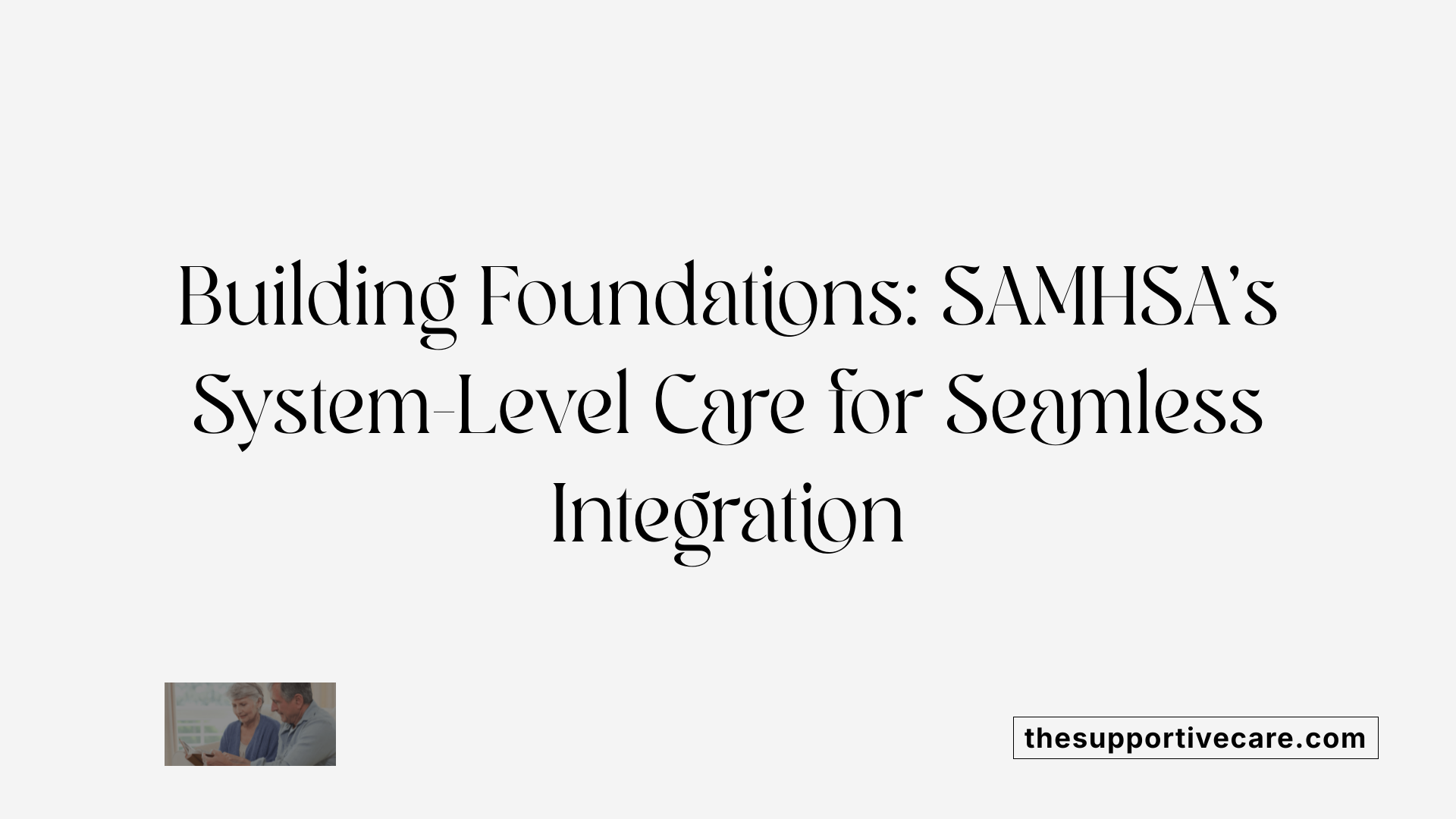
What Are Integrated Treatment Principles?
Integrated treatment is a behavioral health approach that combines mental health and substance-use disorder care within a cohesive framework. This model emphasizes coordinated services that address co-occurring disorders simultaneously rather than in isolation. It promotes collaboration among clinicians, shared decision-making, and communication designed to improve client outcomes and satisfaction. The goal is to provide comprehensive care that acknowledges the complex interactions between mental health and substance use conditions.
How Are Systems Level Care Definitions Relevant?
Systems level care involves structuring organizations, policies, and funding streams to support integration and coordination of behavioral health services. It focuses on connections between clinical teams, administrative leadership, and financing mechanisms to ensure seamless service delivery. This level includes formal agreements between providers, shared electronic health records, and aligned payment models to reduce fragmentation across mental health, substance use treatment, and general healthcare. Such structural support is essential to overcome barriers like disconnected care arrangements and legal restrictions on data sharing.
What Is the Relationship to Care Coordination?
SAMHSA highlights how integrated treatment and systems level care are foundational to effective care coordination. Care coordination requires ongoing communication, trust, and a shared understanding of treatment goals across providers. Integrated models foster these elements by bridging clinical interactions with organizational and systemic structures that facilitate teamwork and information exchange. Together, these approaches help overcome discontinuities in care, improve detection and treatment of co-occurring conditions, and support patient-centered recovery. Ultimately, they serve as pillars for improving behavioral health outcomes through organized, collaborative care networks.
Detection and Treatment Gaps in Co-Occurring Disorders
Under-detection and assessment barriers
Many individuals with co-occurring mental and substance-use disorders often go undetected and unassessed. This under-detection stems largely from the separation of mental health, substance-use, and general healthcare systems. Without integrated screening and assessment protocols, patients may not receive comprehensive evaluations that identify all concurrent conditions.
Separation of services
Mental health, substance-use, and general healthcare services are frequently provided in disconnected settings with separate organizational structures, financial arrangements, and information systems. This fragmentation hinders effective communication and care coordination among providers, creating silos that complicate attempts to treat co-occurring disorders holistically.
Impact on treatment quality
The separation and fragmentation of services lead to discontinuities in care, resulting in diminished treatment quality and poorer health outcomes. Barriers such as privacy laws, regulatory restrictions on information sharing, and distinct organizational policies further obstruct collaboration. These issues contribute to many individuals not receiving timely, appropriate, or integrated treatment.
Strategies to improve this situation focus on formalizing care coordination with shared patient records, case management, and interagency agreements. High-level leadership and policy initiatives aimed at integrating behavioral health services are also essential for addressing these systemic challenges.
Mitigating Care Discontinuities Through Shared Records and Integration
What are the challenges of fragmented information sharing?
Fragmented information sharing across mental health, substance-use, and general healthcare systems leads to significant care discontinuities. These disconnected systems often result in poor communication, delays in treatment, and a lack of coordinated care. Providers may struggle with incomplete patient histories due to legal and organizational barriers, such as privacy laws (HIPAA and substance-use confidentiality regulations) and state statutes that limit data exchange.
How can shared electronic health records improve care coordination?
Shared electronic health records (EHRs) are a critical tool for bridging gaps between services. By enabling providers across different sectors to access a patient's behavioral and general health information securely, EHRs support timely and informed clinical decisions. This transparency fosters a shared understanding of treatment goals, facilitates collaboration, and reduces redundant assessments or conflicting interventions.
What role do formal agreements and clinical integration play?
Beyond technology, establishing formal agreements between organizations sets clear expectations for roles, responsibilities, and information sharing protocols. Such agreements help overcome organizational silos and align incentives toward integrated care delivery. Clinical integration reinforces these efforts by embedding workflows that promote shared decision-making among mental health, substance-use, and general healthcare providers. Together, these strategies streamline service delivery and enhance patient outcomes by ensuring continuity and coordination.
Implementing these approaches—shared electronic records, formal agreements, and clinical integration—forms a comprehensive framework to mitigate care fragmentation. They facilitate communication and trust among providers, ultimately leading to better treatment outcomes for individuals with co-occurring behavioral and physical health needs.
Legal and Policy Barriers to Effective Information Sharing
What privacy laws affect information sharing in behavioral health?
Privacy regulations like the Health Insurance Portability and Accountability Act (HIPAA) and specific substance-use confidentiality laws create strict rules on how patient information must be protected. These laws aim to safeguard sensitive behavioral health data but can limit the ease of sharing information between providers, often causing delays in coordinated care.
How do state statutes impact sharing behavioral health information?
State laws vary widely in their approach to privacy and data sharing for behavioral health services. Some states impose additional restrictions beyond HIPAA, complicating cross-provider communication even further. This patchwork of regulations can hinder the seamless exchange of vital information needed for integrated treatment of mental health and substance use disorders.
What organizational policies contribute to barriers in information exchange?
Individual healthcare organizations often establish their own confidentiality policies, sometimes more restrictive than federal or state laws. These internal rules can stem from concerns over liability, risk management, or interpretations of legal standards, resulting in fragmented or incomplete information sharing. Such policies may prevent providers from accessing full patient histories, obstructing comprehensive care coordination.
Effective coordination of behavioral health care demands navigating these legal and policy complexities. Solutions include developing clear protocols compliant with privacy laws, fostering interagency agreements, and adopting secure shared electronic health records to facilitate appropriate data exchange while respecting patient confidentiality.
Strategies to Improve Care Coordination in Behavioral Health Settings
How does screening for co-occurring conditions improve care coordination?
Universal screening for co-occurring mental health and substance use disorders is a critical first step. Early identification helps providers address multiple conditions simultaneously, rather than treating them in isolation. This approach prevents worsening health, facilitates timely interventions, and reduces emergency care reliance. By identifying these conditions promptly, treatment plans become more comprehensive and tailored to the individual's needs.
What role do treatment and referral plans play in enhancing coordination?
Formal treatment or referral plans ensure continuity and clarity in care. Clearly defined plans facilitate communication among behavioral health, mental health, and general healthcare providers, aligning goals and responsibilities. They help to avoid fragmented care that arises due to disconnected service systems. Referrals are streamlined when providers have consistent protocols, improving client satisfaction and treatment success.
In what ways do case management and organizational support contribute to better care?
Case management acts as a bridge between patients and various healthcare providers, ensuring cohesive service delivery. It supports shared decision-making, trust building, and effective follow-up. Organizational support, including formal agreements and leadership backing, fosters an environment prioritizing collaboration. Such support reinforces policies that overcome information-sharing barriers and promotes integrated treatment systems, enhancing overall care quality.
Together, these strategies combat common coordination barriers like separated services, information-sharing restrictions, and disconnected care arrangements. Implementing universal screening, formalized referral pathways, and robust case management backed by organizational commitment leads to more effective, person-centered behavioral health care.
Leadership and Policy Initiatives Promoting Care Coordination
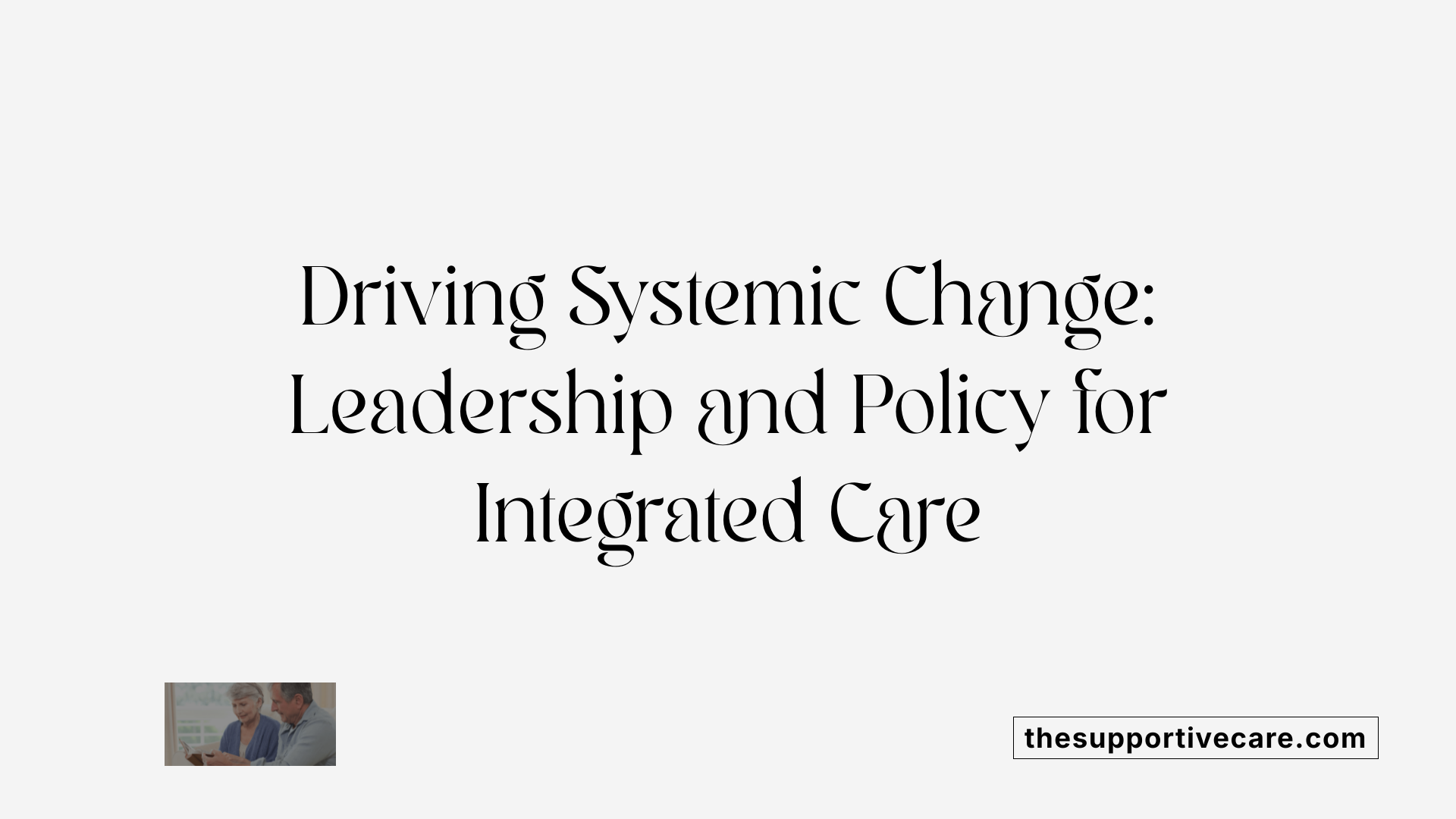
Government-led Programs
Government agencies have taken a central role in promoting care coordination within behavioral health systems. Federal initiatives often focus on creating frameworks that encourage integrated service delivery between mental health, substance-use, and general healthcare providers. These programs provide funding, regulatory support, and technical assistance to help organizations adopt coordinated care models that improve patient outcomes.
Interagency Collaborations
A hallmark of effective care coordination is collaboration across agencies. State and local governments facilitate partnerships among public health, mental health, substance-use treatment, and social service agencies to reduce service fragmentation. These collaborations establish shared protocols, referral networks, and data sharing agreements that enable comprehensive, patient-centered care.
Modeling Care Coordination at High Levels
Top leadership within health systems and policy makers model coordinated care by prioritizing it in organizational goals and resource allocation. High-level leaders champion integrated approaches publicly, ensuring that policies align with care coordination objectives. This leadership creates a culture that values communication, shared decision-making, and trust among providers.
Together, these leadership and policy initiatives are vital for overcoming structural and legal barriers to information sharing and for fostering sustainable behavioral health integration, ultimately enhancing treatment quality and client satisfaction.
Person-Centered, Recovery-Oriented Care: A Community Focus
What is a recovery-oriented approach in behavioral health?
A recovery-oriented approach centers on the individual's own goals and strengths, emphasizing hope, empowerment, and a holistic perspective on well-being. It moves beyond just symptom management to support meaningful life roles, community participation, and personal growth. This person-centered model respects the individuality of each person and fosters collaboration between providers and clients.
How does this approach reduce reliance on institutional care?
Recovery-oriented care actively seeks to reduce the need for acute and institutional settings by offering supportive services within the community. Rather than reacting after crises occur, it promotes early intervention and continuous, coordinated support which can prevent hospitalizations and long-term institutional stays. This shift aligns with modern behavioral health goals to support individuals in their own environments.
What types of community-based supports are important?
Community-based services are vital to recovery and include a range of options such as Certified Community Behavioral Health Centers (CCBHCs), supported employment and housing initiatives, mobile clinics, peer support programs, and crisis response teams. These services help address social determinants of health like housing and nutrition, which are crucial for sustained recovery. They also improve access through outreach, telehealth, and home visits, especially for underserved populations.
Together, these elements create a networked system that integrates care, encourages active participation, and helps individuals maintain wellness within their communities. This approach has been widely embraced in recent policy efforts aimed at transforming behavioral health systems nationwide.
State-Level Innovations Advancing Integrated Behavioral Health Services
What Administrative Simplification Efforts Are States Using to Facilitate Integration?
States are actively streamlining administrative processes to promote behavioral health integration. This involves reducing bureaucratic hurdles that often obstruct the flow of care and coordination across agencies. Simplified eligibility determination, unified application systems, and standardized reporting requirements are examples of how states enhance access and continuity of care for individuals with behavioral health needs.
How Are Payment Reform Models Supporting Integrated Behavioral Health?
Payment reform plays a crucial role in incentivizing integrated care delivery. States are deploying value-based payment models that reward providers for delivering coordinated and holistic services rather than isolated treatments. Examples include enhanced Medicaid reimbursement rates for integrated programs, bundled payments covering both physical and behavioral health services, and outcome-based payments emphasizing patient recovery and quality of life.
What Role Do Joint Licensure Programs Play in Advancing Integration?
Joint licensure programs enable health professionals to be credentialed across multiple disciplines, easing workforce constraints that have historically hindered integration efforts. These programs facilitate seamless provider roles within integrated team settings and encourage interdisciplinary collaboration. By supporting flexible scopes of practice, joint licensure helps expand the provider network capable of delivering comprehensive behavioral health and primary care services.
Together, these state-led innovations address systemic challenges by fostering streamlined administration, incentivizing quality integrated care, and building a versatile workforce infrastructure. Such approaches are foundational to realizing sustainable and effective behavioral health integration at the community level.
The Psychiatric Collaborative Care Model: Evidence and Expansion
How effective is the Psychiatric Collaborative Care Model for treating depression and anxiety?
The Psychiatric Collaborative Care Model (CoCM) has a strong evidence base supporting its effectiveness for treating common behavioral health conditions such as depression and anxiety. Studies show that patients involved in CoCM experience improved mental health outcomes, including reduced symptom severity and better overall functioning. This model allows for early intervention and continuous monitoring, leading to enhanced engagement and reduced need for emergency or inpatient psychiatric care.
What Medicaid reimbursement strategies support the implementation of CoCM?
Several states have adopted Medicaid reimbursement strategies that facilitate the implementation and sustainability of the Collaborative Care Model. By providing reimbursement for services delivered by the multidisciplinary team—including care management and psychiatric consultation—Medicaid encourages widespread adoption. These payment reforms support integrated primary and behavioral health services, making it financially feasible for providers to offer comprehensive care.
What is the multidisciplinary team approach within CoCM?
The Collaborative Care Model is centered around a patient-focused, multidisciplinary team. This team typically includes a primary care provider, a behavioral health care manager, and a consulting psychiatrist. The psychiatrist provides caseload consultation and treatment recommendations, enabling efficient care for a larger group of patients. Regular caseload reviews, patient symptom tracking, and shared decision-making are core features enabling coordinated, measurement-based care.
Overall, CoCM represents a scalable, evidence-driven approach that integrates mental health into primary care through collaborative teamwork and supportive reimbursement mechanisms, expanding access and improving quality for adults with depression and anxiety disorders.
Co-Occurrence Integration Examples: Oregon, New Hampshire, West Virginia

Targeted Programs in State Behavioral Health Integration
Several states are pioneering efforts to better integrate mental health and substance use disorder treatment, particularly for individuals with co-occurring conditions. Oregon, New Hampshire, and West Virginia have launched targeted programs designed to address these overlapping disorders more effectively. These initiatives focus on creating coordinated care pathways that enhance identification, assessment, and individualized treatment plans tailored to the complexities of co-occurring disorders.
Enhanced Medicaid Rates Supporting Integration
A significant mechanism driving these integration efforts is the implementation of enhanced Medicaid reimbursement rates. These higher rates provide financial incentives for providers to invest in integrated service delivery models. By boosting Medicaid payments, states encourage behavioral health providers to adopt practices that improve access to comprehensive care, ensuring clients receive both mental health and substance use treatment concurrently under one system.
Specialty Credentialing to Strengthen Workforce Capacity
In addition to financial incentives, these states emphasize specialty credentialing for providers working with co-occurring disorders. Credentialing programs establish standards and training requirements that enhance the expertise of clinicians and staff. This ensures a qualified workforce capable of delivering integrated, high-quality care tailored to people facing both mental health and substance use challenges. Specialty credentials also help build trust and consistency in service quality across involved agencies.
Together, these strategies reflect a committed approach in Oregon, New Hampshire, and West Virginia to advance integrated care, reduce treatment fragmentation, and improve outcomes for people struggling with co-occurring mental health and substance use disorders.
Behavioral Health Integration for Children and Youth: Specialized Initiatives
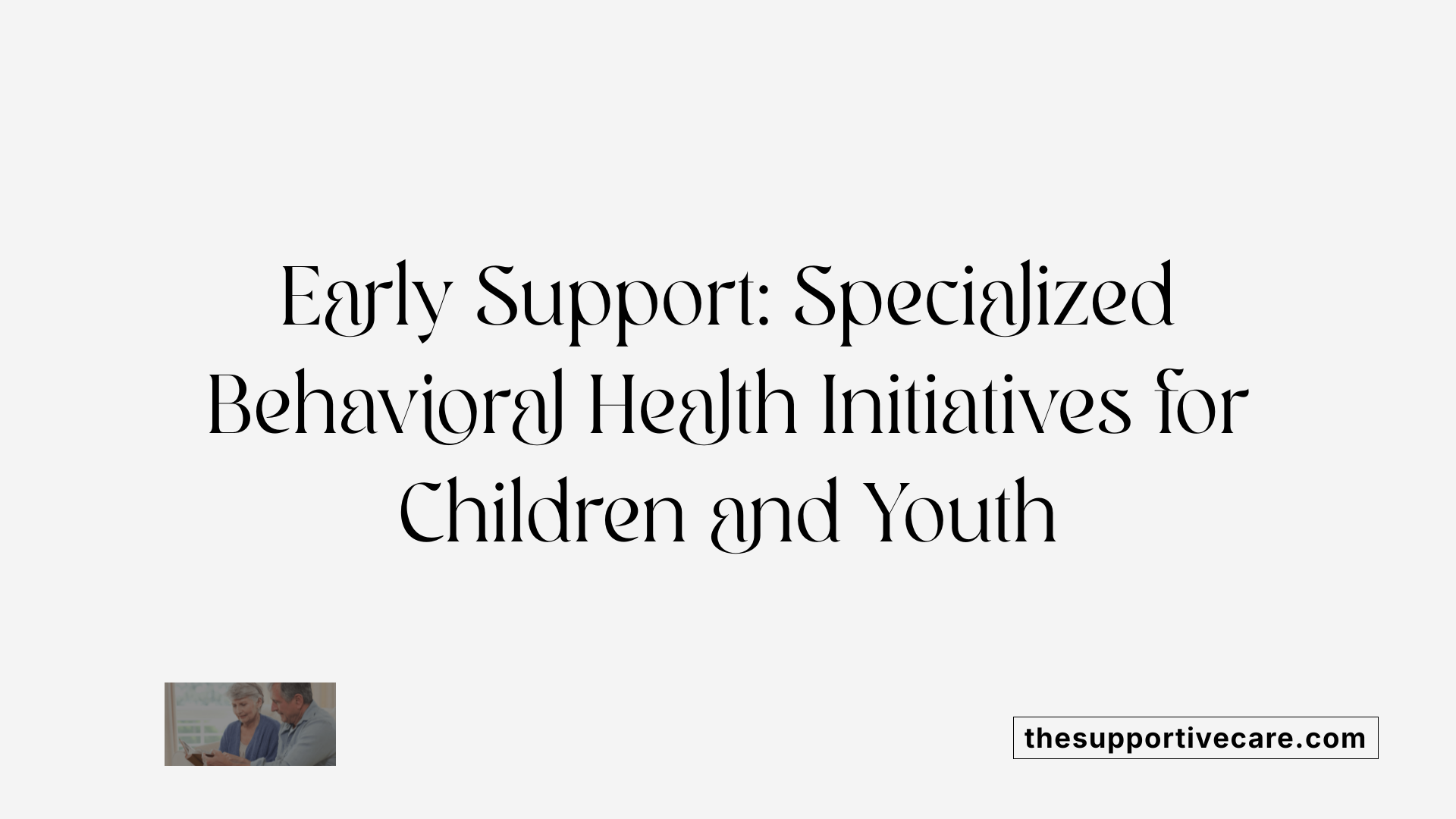
What is Integrated Care for Kids (InCK)?
Integrated Care for Kids (InCK) is a federal initiative designed to improve the health outcomes of children by coordinating physical, behavioral, and social care. It emphasizes comprehensive screening and assessment to identify behavioral health needs early in life. The program promotes collaboration among healthcare providers, schools, and families to create a supportive network that addresses a child's developmental milestones as well as behavioral health concerns.
What are Child Behavioral Health Initiatives?
Child Behavioral Health Initiatives encompass specialized programs focused on the early identification and treatment of mental health and substance use disorders among children and youth. These initiatives offer tailored services that integrate addressing trauma, behavioral challenges, and emotional disorders. They often involve cross-sector partnerships, including pediatric care, mental health services, and educational systems, ensuring a holistic approach to the child’s wellbeing.
How do Early Developmental and Trauma-Focused Services Support Children?
Early developmental and trauma-focused services concentrate on detecting and responding to behavioral health issues that stem from adverse childhood experiences and trauma. These services use evidence-based screening tools and therapeutic interventions targeted to support healthy brain development and emotional regulation. They aim to reduce the long-term impact of trauma by providing timely access to care and supporting resilience in children.
Behavioral health integration for children and youth focuses on coordinated care models that combine early screening, access to mental health treatment, and community and family involvement to improve long-term outcomes.
| Initiative | Primary Focus | Description |
|---|---|---|
| Integrated Care for Kids (InCK) | Comprehensive care coordination | Supports screening, referrals, and collaborative care among providers, schools, and families. |
| Child Behavioral Health Initiatives | Early mental health and trauma treatment | Provides specialized services addressing behavioral disorders and trauma in children and youth. |
| Early Developmental and Trauma-Focused Services | Trauma-informed care | Employs early intervention and therapeutic models to mitigate effects of trauma on development. |
Crisis Care Innovations: Mobile Teams and Stabilization Services
What is the 988 Suicide & Crisis Lifeline?
The 988 Suicide & Crisis Lifeline serves as a national, easily accessible number for individuals experiencing mental health emergencies. This initiative aims to provide immediate crisis support, guide callers to appropriate resources, and reduce reliance on emergency departments and law enforcement.
How do mobile response teams function in crisis care?
Mobile response teams are specially trained groups that promptly travel to individuals facing behavioral health crises. Their presence directly in the community allows for rapid de-escalation, assessment, and connection to less restrictive services. This approach reduces unnecessary hospitalizations and police involvement.
What roles do crisis receiving facilities and peer-operated respite centers play?
Crisis receiving facilities offer safe, short-term placements for individuals undergoing acute episodes. They provide stabilization and triage before determining appropriate next steps. Peer-operated respite centers complement these services by giving voluntary, non-clinical support, leveraging shared lived experiences to foster recovery in a supportive environment.
Together, these innovations aim to transform crisis care by prioritizing compassionate, accessible, and community-based interventions. They emphasize diverting people from traditional emergency and correctional systems toward specialized, recovery-oriented services that respect individual needs and promote better outcomes for diverse populations, including children, youth, rural communities, and Indigenous groups.
Community-Based Services Enhancing Recovery and Integration
What are Certified Community Behavioral Health Centers (CCBHCs)?
Certified Community Behavioral Health Centers (CCBHCs) are specialized community-based providers that deliver comprehensive behavioral health services. They serve as fully integrated primary and behavioral health settings, coordinating care for mental health, substance use disorders, and physical health. CCBHCs emphasize accessibility, offering crisis intervention, prevention, treatment, and recovery-focused services under one roof.
How do supported employment and housing contribute to recovery?
Supported employment and housing are essential for achieving long-term recovery and community integration. These services provide personalized assistance to help individuals with behavioral health challenges secure stable employment and safe housing. Stable living conditions and meaningful work are linked to improved independence, better mental health outcomes, and reduced reliance on institutional care.
How is behavioral health integrated with primary care?
Behavioral health integration with primary care involves coordinating mental health and substance use treatment with routine medical care. This integration promotes whole-person health by addressing co-occurring conditions more effectively. Community-based services, including CCBHCs, often collaborate with primary care providers, facilitating shared treatment plans, joint case management, and streamlined referrals. These efforts help reduce stigma and improve early identification and intervention.
This collaborative, community-focused approach supports recovery by meeting individuals where they are, emphasizing trust and continuity of care, ultimately enhancing quality of life and reducing emergency service use.
From Reactive to Proactive: Transforming Behavioral Health Treatment Models
Historical reactive model limitations
Behavioral health treatment has traditionally operated as a reactive system, waiting for patients to seek help rather than actively reaching out to them. This reactive approach has contributed to substantial unmet needs: in 2019, only 45% of adults with mental illness and a mere 10% with substance use disorder received any treatment. This gap reflects delays in diagnosis, intervention, and ongoing support, which are particularly detrimental for marginalized populations. Furthermore, relying on acute or institutional care rather than proactive, community-centered solutions perpetuates inefficiencies and poorer health outcomes.
Community outreach and active engagement
Transforming behavioral health requires a shift towards community-based, person-centered care that meets individuals where they are. Active outreach efforts like home visits and embedded community services engage clients early and increase treatment accessibility. States are promoting recovery-oriented approaches grounded in community integration, supported by innovations in administrative simplification, payment reform, and interagency collaborations. These initiatives foster coordinated care plans and reduce barriers such as stigma and fragmented services, as well as encourage integrated funding and leadership to sustain systemic change.
Telehealth and mobile clinics
Telehealth and mobile clinics play a vital role in extending behavioral health services to underserved and remote populations. By leveraging technology, care providers deliver timely screenings, counseling, and follow-up without requiring patients to travel to traditional clinics. Mobile crisis teams, crisis stabilization units, and peer-operated respite centers further complement these efforts by offering immediate, community-based support. Policy reforms that expand telehealth use and remove treatment access barriers bolster these models, helping transform behavioral health into a more accessible, integrated, and efficient system.
Addressing the Treatment Gap in Mental Health and Substance Use Disorders
How prevalent is untreated mental health and substance use disorders?
Despite increasing awareness, a significant treatment gap persists. In 2019, only 45% of adults with mental illness and just 10% of those with substance use disorders received treatment. This stark disparity highlights a vast unmet need for behavioral health services across the population.
What are the main barriers to accessing treatment?
Several barriers contribute to low treatment rates for mental health and substance use disorders:
- Stigma: Negative attitudes deter individuals from seeking help and can influence provider responses.
- Workforce shortages: Insufficient numbers of trained behavioral health providers limit availability.
- System fragmentation: Separate mental health, substance use, and general health systems complicate care coordination.
- Regulatory and administrative challenges: Confusing regulations and insurance issues hamper integrated care efforts.
- Privacy laws: Restrictions on sharing behavioral health information can delay or disrupt coordinated care.
- Limited outreach: Traditional treatment models are often reactive rather than proactive, missing those unable or unwilling to present for care.
Why is expanding services important to address these issues?
Expanding behavioral health services is crucial to close the treatment gap. Early intervention based on neuroscience and evidence-based practices improves long-term outcomes, including employment and social integration. Leveraging community-based services, telehealth, and mobile clinics enhances access for underserved populations. Policy reforms such as removing prescribing barriers, expanding Medicaid reimbursement for integrated care models, and addressing social determinants of health further support improved access and equity.
Greater investment in integrated, proactive, and person-centered services can enhance engagement, reduce reliance on acute institutional care, and ultimately improve quality of life for individuals with mental health and substance use disorders.
Policy Reforms to Reduce Barriers and Improve Access
Removing Prescribing Waivers for Medication-Assisted Treatment (MAT)
One important policy reform enhancing access to behavioral health services is the removal of prescribing waivers for MAT. Previously, strict regulations limited which clinicians could prescribe medications like buprenorphine for opioid use disorder. Eliminating these waivers broadens access by enabling more healthcare providers to initiate and manage MAT, a proven effective treatment for substance use disorders. This change supports earlier intervention and reduces barriers related to provider availability.
Expanding Telehealth Services
Telehealth expansion has become a critical strategy in improving behavioral health access, especially for underserved populations. By facilitating remote consultations and therapy sessions, telehealth overcomes geographic and mobility barriers, making care more accessible. Recent policy adjustments promote reimbursement parity for telehealth visits and reduce restrictions on originating sites, encouraging providers to integrate telehealth into routine practice.
Lowering Treatment Thresholds
Lowering the criteria for entering behavioral health treatment is another vital reform. This approach aims to catch behavioral health issues earlier by promoting universal screening and simplifying referral processes. Reducing threshold requirements helps engage individuals who might otherwise delay or avoid care until problems become severe, improving early diagnosis and treatment outcomes.
Collectively, these reforms address systemic hurdles by increasing provider capacity, making services more accessible through technology, and encouraging earlier intervention. They are essential components of a broader effort to transform behavioral health care into a more accessible, integrated, and person-centered system.
Decriminalizing Behavioral Health: Shifting from Punitive to Public Health Approaches
Reducing Incarceration Through Decriminalization
Decriminalizing mental health and substance use disorders is a vital strategy aimed at reducing incarceration rates. Traditional punitive responses often involve law enforcement and criminal justice interventions for individuals experiencing behavioral health crises. This approach not only strains judicial systems but may exacerbate underlying health issues by placing individuals in environments that lack appropriate care. Instead, by shifting towards decriminalization, communities can redirect resources from incarceration to health-centered responses, decreasing the number of people with behavioral health conditions in jail.
Treating Behavioral Health as Health Conditions
Viewing mental health and substance use disorders as health conditions rather than criminal acts emphasizes the necessity of appropriate medical and social care. This approach aligns with the principle of addressing behavioral health needs with compassion, clinical expertise, and community-based support. Health-focused models prioritize early intervention, integrated care, and outreach services, such as mobile crisis teams and telehealth, for comprehensive and timely assistance. These methods help dismantle stigma, promote recovery, and ensure individuals receive treatment tailored to their unique needs.
Benefits of Decriminalization
Decriminalization leads to improved health outcomes by enabling access to evidence-based treatment and reducing the negative consequences associated with incarceration. It supports the development of community crisis response systems, such as mobile crisis units and stabilization beds, which provide timely and non-punitive care during behavioral health emergencies. Additionally, addressing behavioral health through public health frameworks allows for recognition of social determinants like housing and nutrition, which are essential factors in successful recovery. Ultimately, this transition fosters a more equitable system that prioritizes wellness and reduces societal costs linked to punitive responses.
Community Crisis Response Systems Reducing Police Involvement
What are Mobile Crisis Teams?
Mobile crisis teams provide immediate, on-site support for individuals experiencing behavioral health emergencies. These specialized teams, often comprising mental health professionals and peer support workers, are dispatched to assist in crisis situations, offering de-escalation and timely intervention without the involvement of law enforcement. By addressing crises directly in the community, mobile crisis teams reduce the need for emergency department visits and avoid the potential trauma associated with police encounters.
What are Crisis Stabilization Beds?
Crisis stabilization beds offer a short-term, intensive treatment option for individuals in behavioral health crises who need more support than outpatient care but do not require hospitalization. These beds are located in community settings and provide a safe environment for stabilization, assessment, and treatment planning. They serve as an alternative to inpatient psychiatric hospitalization and help prevent unnecessary institutionalization.
How Do These Services Impact Law Enforcement Encounters?
Implementing mobile crisis teams and crisis stabilization beds has been shown to significantly reduce the involvement of police in behavioral health emergencies. This shift allows law enforcement to focus on public safety rather than crisis management. These community-based responses promote more appropriate and compassionate care, decrease the risk of incarceration for individuals with behavioral health needs, and contribute to better overall outcomes by connecting people with tailored services instead of the criminal justice system.
The 988 Suicide and Crisis Lifeline supports many of these initiatives by providing an accessible point of contact and coordinating response resources with a focus on reducing police presence in behavioral health crises.
Recognizing Social Determinants of Health in Behavioral Health Disparities
Housing, Nutrition, Environment
Stable housing, adequate nutrition, and a safe environment are fundamental to behavioral health. Individuals lacking secure housing face heightened stress and exposure to conditions that exacerbate mental health and substance use disorders. Nutrition influences brain function and mood regulation, while environmental stressors such as pollution or neighborhood violence can increase the risk of behavioral health problems. Addressing these factors is essential for improving treatment outcomes and promoting recovery.
Structural Racism
Structural racism creates systemic barriers that disproportionately affect marginalized communities, contributing to disparities in behavioral health care access and quality. Discriminatory policies and social inequities lead to reduced opportunities for education, employment, and healthcare, increasing vulnerability to behavioral health conditions. Recognizing and confronting these inequities is critical to designing equitable behavioral health services that effectively serve diverse populations.
Impact on Outcomes
The interplay of social determinants negatively influences behavioral health outcomes by limiting access to care, reducing treatment adherence, and increasing chronic stress. Individuals facing housing instability or discrimination often experience more severe symptoms and poorer recovery rates. Integrating social determinants into treatment planning enhances care coordination and promotes holistic recovery, aligning with person-centered, recovery-oriented approaches that emphasize community support and long-term well-being.
Early Intervention and Neuroscience-Informed Approaches
What Are the Benefits of Early Intervention?
Early intervention in behavioral health can substantially improve long-term outcomes for individuals dealing with mental illness and substance use disorders. By addressing problems early, it enhances patient engagement in treatment, increases the likelihood of sustained recovery, and decreases the need for more intensive or costly services later on. Early care reduces chronic disability, minimizes hospital admissions, and supports better social integration.
How Does Early Intervention Improve Engagement and Outcomes?
Focusing on early intervention encourages individuals to participate actively in their treatment journey. It can lead to higher employment rates and improved quality of life by addressing behavioral health challenges before they escalate. Early identification and responsive care models foster therapeutic alliances, which are vital for motivating clients and sustaining meaningful progress.
In What Ways Does Neuroscience and Clinical Research Support Early Intervention?
Modern neuroscience and clinical research have elucidated the brain changes tied to mental health and substance use conditions. This growing knowledge enables the development of targeted interventions that are more effective and personalized. Insights into neuroplasticity, stress response, and developmental trajectories guide clinicians in applying evidence-based strategies that optimize brain health and resilience. Consequently, interventions rooted in neuroscience contribute to recovery by tailoring treatment timing and intensity aligned with individual biological and psychological needs.
Workforce Development: Essential for System Transformation
Why Is Expanding Training Vital?
Effective behavioral health care requires a workforce skilled in the latest clinical approaches and able to address complex patient needs. Expanding training opportunities ensures that providers are equipped with evidence-based techniques, such as integrated care models and trauma-informed practices. Training also prepares clinicians to collaborate across disciplines, enhancing care coordination vital for treating co-occurring mental health and substance use disorders.
How Does Increasing Diversity Improve Care?
A diverse behavioral health workforce brings cultural competence and sensitivity to treatment, helping to reduce disparities among marginalized populations. Increasing diversity improves patient-provider relationships, promotes trust, and supports person-centered, recovery-oriented care. Diverse teams are better positioned to understand and address social determinants of health, structural racism, and linguistic needs.
What Role Does Peer Support Inclusion Play?
Including peer support specialists—individuals with lived experience—adds a unique dimension to care. Peer supporters provide empathy, advocacy, and practical guidance that traditional providers may not offer. Their inclusion promotes engagement, reduces stigma, and bolsters recovery-oriented systems. Integrating peer support aligns with community-based approaches and helps bridge gaps between clinical services and patients' everyday lives.
Accountability Focused on Outcomes, Not Just Service Provision
Measuring Independence and Employment
Accountability in behavioral health systems is increasingly emphasizing real-life outcomes such as patients' independence and employment status. These measures go beyond simply tracking service delivery, focusing instead on how effectively treatment supports individuals in leading autonomous and productive lives. Employment is a critical indicator because it reflects a person's ability to integrate into society and maintain financial stability, which are important markers of successful recovery and community participation.
Quality of Life Indicators
Quality of life is a broad yet essential outcome that encapsulates physical health, emotional well-being, social relationships, and overall life satisfaction. Behavioral health programs are shifting towards using quality of life measures as part of accountability frameworks to assess whether services truly enhance patients' daily functioning and happiness. These indicators help highlight improvements in social integration, community engagement, and personal fulfillment, which traditional service metrics often miss.
Beyond Service Quantity
While monitoring service provision, such as number of sessions or treatment hours, remains important, accountability strategies are evolving to prioritize outcomes that matter most to patients. This means moving beyond quantity—how much care is provided—to quality and impact—how care changes lives. Focusing on outcomes like independence, employment, and quality of life encourages providers to tailor treatment plans, improve coordination, and innovate interventions that address the whole person rather than just symptoms or diagnoses.
Integrated Funding and Cross-Sector Collaboration as Foundations for Change
Why Is Data Sharing Important in Behavioral Health Integration?
Effective data sharing is critical for coordinated care in behavioral health systems. Disconnected care arrangements—caused by separate organizational and financial structures—significantly hinder treatment coordination and quality. Privacy laws such as HIPAA, substance-use confidentiality laws, state statutes, and organizational policies create barriers, complicating necessary data exchange. To overcome this, formal agreements, shared electronic health records, and clinical integration efforts help providers communicate efficiently, supporting shared decision-making and improved health outcomes for clients with complex needs.
How Do Cross-Sector Approaches Improve Behavioral Health Outcomes?
Cross-sector collaboration brings together mental health, substance-use, and general healthcare providers to address co-occurring disorders and associated medical conditions, emphasizing a whole-person approach. This includes partnerships across public, private, and nonprofit organizations, integrating services at the organizational and community level. Examples include joint licensure programs, administrative simplification, and combined funding streams encouraging integrated service delivery. Leadership initiatives at the state and federal levels model coordination, ensuring systems work collectively to reduce gaps and duplications in care.
What Enables Sustainable Systemic Transformation?
Sustainable transformation demands coordinated funding mechanisms coupled with comprehensive cross-sector collaborations. Integrated funding aligns incentives, promotes accountability beyond service volume to outcomes like quality of life and employment, and supports workforce development and community-based recovery models. Policies promoting co-management of budgets and data encourage innovation and continuous improvement. Together, they facilitate a shift from reactive, fragmented care to proactive, person-centered systems that meet clients where they are, ultimately improving access, engagement, and treatment effectiveness.
Universal Screening and Early Identification in Primary Care
Universal behavioral health screening
Universal screening for behavioral health conditions in primary care settings involves systematically assessing all patients for mental health and substance use disorders regardless of presenting complaints. This approach enables healthcare providers to detect issues earlier than waiting for symptoms to become severe. Screening tools are brief questionnaires or interviews integrated into routine care visits, ensuring early identification and triage for those in need.
Early intervention benefits
Early identification of behavioral health conditions allows for timely intervention, which can significantly improve long-term outcomes. When mental health and substance use disorders are recognized early, treatments can be introduced before the conditions worsen. This proactive approach enhances patient engagement, supports employment and social integration, and reduces the risk of chronic disability. Early intervention also aligns with neuroscience and clinical research emphasizing brain plasticity and recovery potential in initial disease stages.
Preventing costly emergency and inpatient care
By catching behavioral health problems at an early stage, universal screening can prevent progression to crisis levels that require expensive emergency or inpatient care. Studies show that patients identified through integrated screening models are less likely to experience psychiatric emergencies or hospitalizations. Reducing such high-cost services helps both patients and healthcare systems by keeping care community-based and supports more sustainable care delivery models.
Together, universal behavioral health screening in primary care and early intervention represent vital strategies to close treatment gaps, improve patient outcomes, and reduce unnecessary healthcare expenditures.
Models Supporting Behavioral Health Integration: Collaborative Care and PCBH
What Are the Core Principles of the Collaborative Care Model?
The Collaborative Care Model (CoCM) is an evidence-based approach that enhances behavioral health integration within primary care settings. It relies on a multidisciplinary, patient-centered team comprising primary care providers, a behavioral health care manager, and a consulting psychiatrist. This structure allows psychiatrists to extend their expertise over a larger patient population efficiently.
Population-based care is a central tenet, using registries to track patients and regular caseload reviews to monitor progress. Measurement-based care is also essential, with symptom assessments conducted routinely to adjust treatment as needed. These elements contribute to better mental and physical health outcomes and reduce reliance on emergency or inpatient psychiatric services.
How Does the Primary Care Behavioral Health (PCBH) Model Function?
The PCBH Model embeds behavioral health consultants directly within primary care clinics. This setup enables same-day, brief interventions by generalist clinicians who coordinate closely with primary care providers. The goal is to provide immediate, integrated support for behavioral health concerns as part of routine medical care.
This model enhances accessibility and helps manage behavioral health conditions efficiently without the need for separate specialty referrals. It also promotes coordinated care and early intervention, improving overall outcomes.
How Is SBIRT Integrated into Behavioral Health Services?
SBIRT—Screening, Brief Intervention, and Referral to Treatment—is a streamlined process that integrates behavioral health screening into primary care. Universal screening identifies individuals at risk for substance use and other behavioral health issues early.
Brief interventions provide timely counseling to motivate patients toward healthier choices. For those requiring additional support, referral to specialty treatment is facilitated within the same care framework. This integration simplifies behavioral health service delivery, making it a seamless part of primary care.
Together, these models demonstrate practical and effective strategies for embedding behavioral health care into general medical settings, thereby improving access, outcomes, and patient satisfaction.
Reducing Stigma Through Integration and Public Education
How does integration normalize mental health screening?
Integrating behavioral health into primary care settings helps normalize mental health screening by making it a routine part of health assessments, just like checking blood pressure or cholesterol. This routine approach reduces the perception that mental health is separate or abnormal, encouraging patients to discuss mental health openly. For example, universal screening in primary care allows earlier identification of mental health and substance use issues without singling out patients.
What are the impacts on patient and provider attitudes?
Integration reduces stigma by improving patient comfort with seeking care for behavioral health issues. Patients are less likely to feel isolated or judged when services are provided alongside primary health care. For providers, collaborative care models foster a team-based approach where mental health is viewed as an essential component of overall health. This shared perspective increases provider confidence in addressing behavioral health and helps combat biases or misconceptions.
What role do public education campaigns play?
Public education campaigns are crucial in shifting attitudes and reducing stigma around behavioral health. These efforts aim to increase awareness about mental illness and substance use disorders as common, treatable conditions rather than moral failings. Education promotes understanding, encourages people to seek help early, and supports advocacy for integrated care. Campaigns also target stigma within healthcare providers, further promoting acceptance and empathetic care.
Together, integration initiatives and public education help dismantle stigma by normalizing mental health discussions, fostering positive attitudes, and encouraging system-wide cultural change that supports patient-centered recovery.
Consistency in Staffing: The Foundation for Quality Comprehensive Treatment
Role in Delivering Multifaceted Treatments
Consistency in staffing is vital for effectively delivering complex, multifaceted treatments in substance abuse and mental health care. Comprehensive services typically include assessment, detoxification, medication-assisted treatment, therapies, counseling to address co-occurring disorders, and relapse prevention efforts. A stable and well-trained team ensures that every stage of treatment is seamlessly connected, reducing gaps and enhancing the quality of care.
Impact on Client Trust and Engagement
Clients build trust and engage more deeply when they interact consistently with familiar treatment staff. Higher staffing ratios and consistency allow providers to give more personalized attention, which research links to better treatment outcomes and increased client satisfaction. Familiarity enables staff to recognize individual needs and challenges, fostering a supportive environment where clients are more likely to remain involved in their recovery journey.
Essential for Aftercare and Relapse Prevention
Aftercare and relapse prevention are cornerstone elements of maintaining long-term recovery. Consistent staff play an essential role by providing ongoing therapeutic support, facilitating participation in support groups, and helping clients develop coping strategies. Their continuity enables regular progress monitoring and early intervention if relapse signs emerge, significantly reducing the risk of setbacks.
Related Insights
| Component | Importance | Staffing Requirement |
|---|---|---|
| Assessment | Accurate diagnosis and treatment planning | Skilled staff for thorough evaluations |
| Medication-Assisted Treatment | Supports withdrawal and reduces cravings | Staff trained in pharmacotherapy and monitoring |
| Therapy and Counseling | Addresses psychological and behavioral aspects | Consistent providers to build rapport and trust |
| Aftercare and Relapse Prevention | Sustains recovery and prevents relapse | Ongoing staff engagement for support and intervention |
In summary, maintaining consistent staffing levels is not only about quantity but also about the quality and continuity of care that comprehensive behavioral health treatments demand. This consistency fosters trust, engagement, and continuous support critical to effective recovery and long-term wellness.
Sustaining Excellence: Staffing Consistency as the Keystone in Behavioral Health Success
Consistent staffing in behavioral health care is not merely an operational concern but a vital element that underpins effective, comprehensive treatment for substance use and mental health disorders. Stabilized staffing ratios enhance individualized attention, support integrated care coordination, and ensure continuity across the treatment continuum—factors essential for improving outcomes and client satisfaction. As policies evolve and models integrate care more deeply, investing in workforce stability, training, and collaboration becomes imperative. Ultimately, fostering consistency in behavioral health staffing equips systems to better serve vulnerable populations, bridge treatment gaps, and champion recovery-oriented, community-based care that transforms lives.
References
- Factors That Influence Staffing of Outpatient Substance ...
- Coordinating Care for Better Mental, Substance-Use ... - NCBI
- Behavioral Health System Modernization along the ...
- Transforming Mental Health And Addiction Services
- Understanding integrated behavioral health care and the ...
- The Integration of Care for Mental Health, Substance ...
- Home | SAMHSA - Substance Abuse and Mental Health ...
- Therapy For Substance Abuse Treatment











